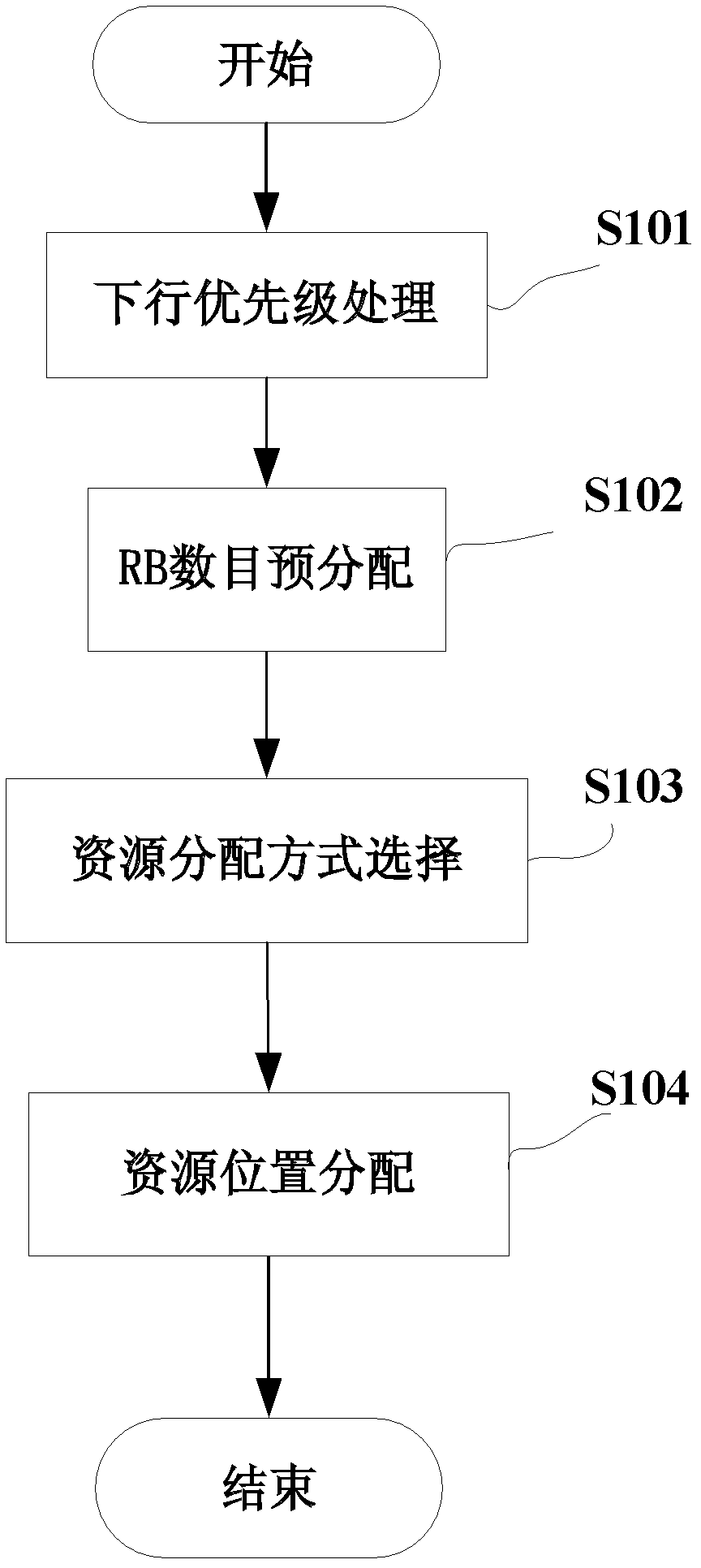PDSCH (physical downlink shared channel) resource distribution method and PDSCH resource distribution system
A physical downlink sharing and channel resource technology, applied in the field of PDSCH wireless resource allocation, can solve the problem of low utilization rate of PDSCH resources, achieve good flexibility, avoid resource waste, and control channel overhead.
- Summary
- Abstract
- Description
- Claims
- Application Information
AI Technical Summary
Problems solved by technology
Method used
Image
Examples
Embodiment 1
[0100] In the following, resource mode and resource quantity are configured for UEs in a certain LTE cell, assuming that the system bandwidth is 5 MHz, that is, 25 RBs are available. There are currently 10 UEs in the scheduling queue in the cell, and the ID numbers are 1, 2, 3, 4, 5, 6, 7, 8, 9, and 10 respectively.
[0101] (1) The MAC queues up the 10 UEs and outputs the queue {3, 4, 1, 10, 6, 8, 9, 5, 2, 7}.
[0102] (2) Pre-allocate a certain number of RBs to each UE in the queue according to the UE's buffer information, channel conditions, service types, remaining resources, etc., that is, pre-determine the number of RBs allocated to each UE, represented by Nrb. Assuming that the expanded resources N=5, then the total number of resources that can be allocated at this time is 30. The number of pre-allocated RBs for each UE is as follows:
[0103] Nrb3=7, Nrb4=3, Nrb1=3, Nrb10=6, Nrb6=4, Nrb8=2, Nrb9=3, Nrb5=2, the following UEs have no resources to divide.
[0104] (3) ...
Embodiment 2
[0116] Next, configure the resource mode and resource number for UEs in an LTE cell, assuming that the system bandwidth is 3MHz, that is, 15 RBs are available. There are currently 10 UEs in the scheduling queue in the cell, and the ID numbers are 1, 2, 3, 4, 5, 6, 7, 8, 9, and 10 respectively.
[0117] (1) The MAC queues up the 10 UEs and outputs the queue {3, 4, 1, 10, 6, 8, 9, 5, 2, 7}.
[0118] (2) According to the buffer information of the UE, channel conditions, service types, remaining resources, etc., a certain number of RBs are pre-allocated to each UE in the queue, denoted by Nrb. Assuming that the expanded resource N=5, then the total number of resources that can be allocated at this time is 20. The pre-allocation results are as follows:
[0119] Nrb3=5, Nrb4=3, Nrb1=3, Nrb10=4, Nrb6=2, Nrb8=3, the following UEs have no resources to divide.
[0120] (3) Determination and mapping of resource modes:
[0121] 1) After judgment, UE: 4 and 1 are distributed allocation...
Embodiment 3
[0129] Next, configure the resource mode and resource number for UEs in an LTE cell, assuming that the system bandwidth is 3MHz, that is, 15 RBs are available. There are currently 10 UEs in the scheduling queue in the cell, and the ID numbers are 1, 2, 3, 4, 5, 6, 7, 8, 9, and 10 respectively.
[0130] (1) The MAC queues up the 10 UEs and outputs the queue {3, 4, 1, 10, 6, 8, 9, 5, 2, 7}.
[0131] (2) According to the UE's buffer information, channel conditions, service types, remaining resources, etc., a certain number of RBs are pre-allocated to each UE in the queue, expressed as Nrb. Assuming that the expanded resource N=5, then the total number of resources that can be allocated at this time is 20. The pre-allocation results are as follows:
[0132] Nrb3=2, Nrb4=4, Nrb1=6, Nrb10=4, Nrb6=1, Nrb8=3, the following UEs have no resources to divide.
[0133] (3) Determination and mapping of resource allocation methods:
[0134] 1) After judgment, UE: 3, 4, and 1 are distribu...
PUM
 Login to View More
Login to View More Abstract
Description
Claims
Application Information
 Login to View More
Login to View More - R&D
- Intellectual Property
- Life Sciences
- Materials
- Tech Scout
- Unparalleled Data Quality
- Higher Quality Content
- 60% Fewer Hallucinations
Browse by: Latest US Patents, China's latest patents, Technical Efficacy Thesaurus, Application Domain, Technology Topic, Popular Technical Reports.
© 2025 PatSnap. All rights reserved.Legal|Privacy policy|Modern Slavery Act Transparency Statement|Sitemap|About US| Contact US: help@patsnap.com



